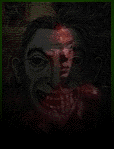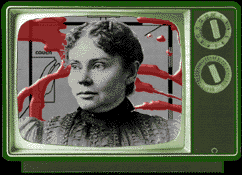
Sobchack recalls the monstrously aging women in horror films she saw as a child in the 1950s as she meditates on the anxieties that attend middle age. Such low-budget horror films as Attack of the 50 Foot Woman (1958), The Wasp Woman (1959), and The Leech Woman (1960) are morally charged stories that represent the aging woman as both scary and scared, as frightening to others as she is to herself. Excessive by virtue of her age and gender, and doubly monstrous in that she
experiences desire even while she is no longer perceived as desirable, the aging woman offers an alternative to the monstrous women that feminist theory has described; her scariness has "less to do with sexual desire and castration anxiety than with abjection and death." Sobchack weaves together her own perception of aging with accounts of abject middle-aged women from popular psychology, high theory, and Hollywood horror film to unravel our culture's complicated response to aging women.

 Creed examines the figure of the monstrous little girl in films
ranging from Curse of the Cat People (1944) and The Bad Seed (1956) to Carrie (1976) and The Brood (1979). Drawing on Julia Kristeva's notion of the abject as that which threatens to breach the symbolic boundaries erected
by civilized society, Creed argues that Hollywood's monstrous children
inhabit the borders "between human and animal, male and female, living and dead, clean and unclean, natural and supernatural, innocence and evil, adult and child" and are consequently both horrifying and appealing. Dividing her essay into three thematic categories -- the mystical child, the possessed girl, and the monstrous daughter -- Creed explores the horrifying appeal of images of corrupted innocence that proliferate on the Hollywood screen.
Creed examines the figure of the monstrous little girl in films
ranging from Curse of the Cat People (1944) and The Bad Seed (1956) to Carrie (1976) and The Brood (1979). Drawing on Julia Kristeva's notion of the abject as that which threatens to breach the symbolic boundaries erected
by civilized society, Creed argues that Hollywood's monstrous children
inhabit the borders "between human and animal, male and female, living and dead, clean and unclean, natural and supernatural, innocence and evil, adult and child" and are consequently both horrifying and appealing. Dividing her essay into three thematic categories -- the mystical child, the possessed girl, and the monstrous daughter -- Creed explores the horrifying appeal of images of corrupted innocence that proliferate on the Hollywood screen.

Woman, Red in Tooth and Claw
 Carter explores the roots of "Angry Essentialism," which emerged in the 1980s in the work of feminist performance artists such as Holly Hughes, Karen Finley, and Andrea Juno. Angry Essentialism embraces the association of Woman with the chaos and violence of Nature, employing this archetypal equation as a weapon against oppression. However, by tracing the origins of Angry Essentialism to the nineteenth-century French poet Arthur Rimbaud and the image of the poete maudit, Carter demonstrates that, even when appropriated by feminists, Rimbaud's model is based on binary oppositions that reinforce the devaluation of women. Further, the male avant-garde deliberately adopted the image of the base and violent Woman in order to free themselves of the the constricting image of the rational and civilized Man. But can women artists produce the same effect by adopting the persona of the Angry Woman? While the performances of Hughes and Finley attempt to obliterate the image of woman as the oppressed, nurturing Earth Mother, they merely invoke her mirror image, the Devouring Mother. As a consequence, Carter argues, while the male avant-garde presents the decadent state as liberating, feminist performance artists who adopt Angry Essentialism often inadvertently reinforce a conception of the 'feminine' which validates the oppression of women.
Carter explores the roots of "Angry Essentialism," which emerged in the 1980s in the work of feminist performance artists such as Holly Hughes, Karen Finley, and Andrea Juno. Angry Essentialism embraces the association of Woman with the chaos and violence of Nature, employing this archetypal equation as a weapon against oppression. However, by tracing the origins of Angry Essentialism to the nineteenth-century French poet Arthur Rimbaud and the image of the poete maudit, Carter demonstrates that, even when appropriated by feminists, Rimbaud's model is based on binary oppositions that reinforce the devaluation of women. Further, the male avant-garde deliberately adopted the image of the base and violent Woman in order to free themselves of the the constricting image of the rational and civilized Man. But can women artists produce the same effect by adopting the persona of the Angry Woman? While the performances of Hughes and Finley attempt to obliterate the image of woman as the oppressed, nurturing Earth Mother, they merely invoke her mirror image, the Devouring Mother. As a consequence, Carter argues, while the male avant-garde presents the decadent state as liberating, feminist performance artists who adopt Angry Essentialism often inadvertently reinforce a conception of the 'feminine' which validates the oppression of women.

 Adler uncovers the mythology surrounding the murder of Lizzie Borden's parents in 1892. Drawing on contemporary newspaper accounts and biographies as well as popular poems and novels, Adler explores the ways in which gender and class differences are expressed in the varying versions of the story. Through a detailed examination of a made-for-television-movie, The Legend of Lizzie Borden (1974), she demonstrates that, though current accounts stray considerably from the historical record of Borden's trial, they represent the calcification of the often contradictory details of the history and legend of Lizzie Borden.
Adler uncovers the mythology surrounding the murder of Lizzie Borden's parents in 1892. Drawing on contemporary newspaper accounts and biographies as well as popular poems and novels, Adler explores the ways in which gender and class differences are expressed in the varying versions of the story. Through a detailed examination of a made-for-television-movie, The Legend of Lizzie Borden (1974), she demonstrates that, though current accounts stray considerably from the historical record of Borden's trial, they represent the calcification of the often contradictory details of the history and legend of Lizzie Borden.

 Creed examines the figure of the monstrous little girl in films
ranging from Curse of the Cat People (1944) and The Bad Seed (1956) to Carrie (1976) and The Brood (1979). Drawing on Julia Kristeva's notion of the abject as that which threatens to breach the symbolic boundaries erected
by civilized society, Creed argues that Hollywood's monstrous children
inhabit the borders "between human and animal, male and female, living and dead, clean and unclean, natural and supernatural, innocence and evil, adult and child" and are consequently both horrifying and appealing. Dividing her essay into three thematic categories -- the mystical child, the possessed girl, and the monstrous daughter -- Creed explores the horrifying appeal of images of corrupted innocence that proliferate on the Hollywood screen.
Creed examines the figure of the monstrous little girl in films
ranging from Curse of the Cat People (1944) and The Bad Seed (1956) to Carrie (1976) and The Brood (1979). Drawing on Julia Kristeva's notion of the abject as that which threatens to breach the symbolic boundaries erected
by civilized society, Creed argues that Hollywood's monstrous children
inhabit the borders "between human and animal, male and female, living and dead, clean and unclean, natural and supernatural, innocence and evil, adult and child" and are consequently both horrifying and appealing. Dividing her essay into three thematic categories -- the mystical child, the possessed girl, and the monstrous daughter -- Creed explores the horrifying appeal of images of corrupted innocence that proliferate on the Hollywood screen. Carter explores the roots of "Angry Essentialism," which emerged in the 1980s in the work of feminist performance artists such as Holly Hughes, Karen Finley, and Andrea Juno. Angry Essentialism embraces the association of Woman with the chaos and violence of Nature, employing this archetypal equation as a weapon against oppression. However, by tracing the origins of Angry Essentialism to the nineteenth-century French poet Arthur Rimbaud and the image of the poete maudit, Carter demonstrates that, even when appropriated by feminists, Rimbaud's model is based on binary oppositions that reinforce the devaluation of women. Further, the male avant-garde deliberately adopted the image of the base and violent Woman in order to free themselves of the the constricting image of the rational and civilized Man. But can women artists produce the same effect by adopting the persona of the Angry Woman? While the performances of Hughes and Finley attempt to obliterate the image of woman as the oppressed, nurturing Earth Mother, they merely invoke her mirror image, the Devouring Mother. As a consequence, Carter argues, while the male avant-garde presents the decadent state as liberating, feminist performance artists who adopt Angry Essentialism often inadvertently reinforce a conception of the 'feminine' which validates the oppression of women.
Carter explores the roots of "Angry Essentialism," which emerged in the 1980s in the work of feminist performance artists such as Holly Hughes, Karen Finley, and Andrea Juno. Angry Essentialism embraces the association of Woman with the chaos and violence of Nature, employing this archetypal equation as a weapon against oppression. However, by tracing the origins of Angry Essentialism to the nineteenth-century French poet Arthur Rimbaud and the image of the poete maudit, Carter demonstrates that, even when appropriated by feminists, Rimbaud's model is based on binary oppositions that reinforce the devaluation of women. Further, the male avant-garde deliberately adopted the image of the base and violent Woman in order to free themselves of the the constricting image of the rational and civilized Man. But can women artists produce the same effect by adopting the persona of the Angry Woman? While the performances of Hughes and Finley attempt to obliterate the image of woman as the oppressed, nurturing Earth Mother, they merely invoke her mirror image, the Devouring Mother. As a consequence, Carter argues, while the male avant-garde presents the decadent state as liberating, feminist performance artists who adopt Angry Essentialism often inadvertently reinforce a conception of the 'feminine' which validates the oppression of women.
 Adler uncovers the mythology surrounding the murder of Lizzie Borden's parents in 1892. Drawing on contemporary newspaper accounts and biographies as well as popular poems and novels, Adler explores the ways in which gender and class differences are expressed in the varying versions of the story. Through a detailed examination of a made-for-television-movie, The Legend of Lizzie Borden (1974), she demonstrates that, though current accounts stray considerably from the historical record of Borden's trial, they represent the calcification of the often contradictory details of the history and legend of Lizzie Borden.
Adler uncovers the mythology surrounding the murder of Lizzie Borden's parents in 1892. Drawing on contemporary newspaper accounts and biographies as well as popular poems and novels, Adler explores the ways in which gender and class differences are expressed in the varying versions of the story. Through a detailed examination of a made-for-television-movie, The Legend of Lizzie Borden (1974), she demonstrates that, though current accounts stray considerably from the historical record of Borden's trial, they represent the calcification of the often contradictory details of the history and legend of Lizzie Borden.